南京夫子庙英文导游词
- 格式:docx
- 大小:15.00 KB
- 文档页数:11
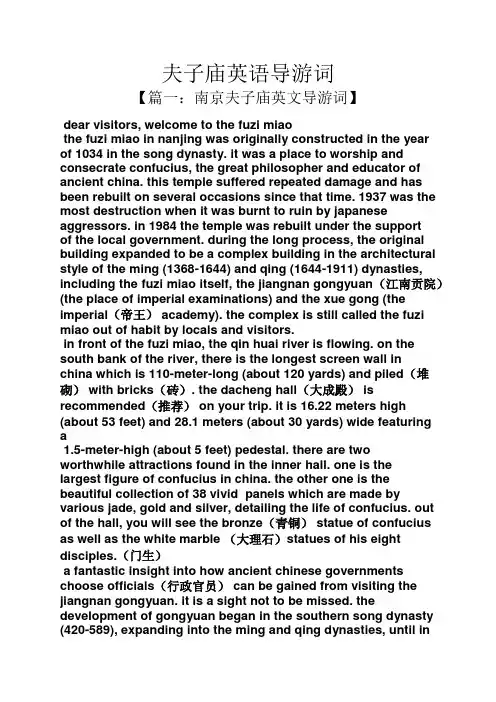
夫子庙英语导游词【篇一:南京夫子庙英文导游词】dear visitors, welcome to the fuzi miaothe fuzi miao in nanjing was originally constructed in the yearof 1034 in the song dynasty. it was a place to worship and consecrate confucius, the great philosopher and educator of ancient china. this temple suffered repeated damage and has been rebuilt on several occasions since that time. 1937 was the most destruction when it was burnt to ruin by japanese aggressors. in 1984 the temple was rebuilt under the supportof the local government. during the long process, the original building expanded to be a complex building in the architectural style of the ming (1368-1644) and qing (1644-1911) dynasties, including the fuzi miao itself, the jiangnan gongyuan(江南贡院)(the place of imperial examinations) and the xue gong (the imperial(帝王) academy). the complex is still called the fuzi miao out of habit by locals and visitors.in front of the fuzi miao, the qin huai river is flowing. on the south bank of the river, there is the longest screen wall inchina which is 110-meter-long (about 120 yards) and piled(堆砌) with bricks(砖). the dacheng hall(大成殿) is recommended(推荐) on your trip. it is 16.22 meters high (about 53 feet) and 28.1 meters (about 30 yards) wide featuringa1.5-meter-high (about 5 feet) pedestal. there are twoworthwhile attractions found in the inner hall. one is thelargest figure of confucius in china. the other one is the beautiful collection of 38 vivid panels which are made by various jade, gold and silver, detailing the life of confucius. out of the hall, you will see the bronze(青铜) statue of confucius as well as the white marble (大理石)statues of his eight disciples.(门生)a fantastic insight into how ancient chinese governments choose officials(行政官员) can be gained from visiting the jiangnan gongyuan. it is a sight not to be missed. the development of gongyuan began in the southern song dynasty (420-589), expanding into the ming and qing dynasties, until inthe reign of emperor guangxu in the qing dynasty. it developed to be the biggest exanimation school in china. the main building of gongyuan is the three-storied mingyuan tower which is surrounded by 20,644 examination cells, called haoshe in chinese. now, a specialized museum on the imperial civil examination system is built here. visitors also have the opportunity to take simulated exams and experience the joys and sorrows of the candidates.the area around the temple consists of a series of tourist shops, snack bars, restaurants and tea cafes. they all appear to be in the architectural style of the ming and qing style. a variety of snacks encompassing eight of the most famous flavours are available for purchase at here. everyones individual tastes are well catered for. they are necessary parts of food culture in nanjing.【篇二:夫子庙导游词】南京夫子庙导游词英文考试版(2008-07-30 16:27:03)孔庙和秦淮河风光带1:the confucius temple, located [lou?keitid位于]at the qinhuai river scenic[si:nik风景的] area, 孔庙位于秦淮河风光带6the temple is the place for people to pay worship to confucius.庙是供人们崇拜孔子的地方 7:the confucius temple here in nanjing was first built in 1034孔庙在南京第一次建于1034。
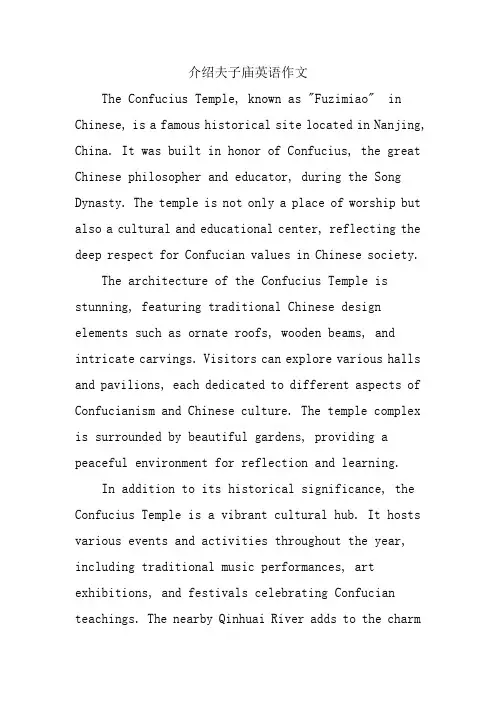
介绍夫子庙英语作文The Confucius Temple, known as "Fuzimiao" in Chinese, is a famous historical site located in Nanjing, China. It was built in honor of Confucius, the great Chinese philosopher and educator, during the Song Dynasty. The temple is not only a place of worship but also a cultural and educational center, reflecting the deep respect for Confucian values in Chinese society.The architecture of the Confucius Temple is stunning, featuring traditional Chinese design elements such as ornate roofs, wooden beams, and intricate carvings. Visitors can explore various halls and pavilions, each dedicated to different aspects of Confucianism and Chinese culture. The temple complex is surrounded by beautiful gardens, providing a peaceful environment for reflection and learning.In addition to its historical significance, the Confucius Temple is a vibrant cultural hub. It hosts various events and activities throughout the year, including traditional music performances, art exhibitions, and festivals celebrating Confucian teachings. The nearby Qinhuai River adds to the charmof the area, offering scenic boat rides that allow visitors to appreciate the beauty of the surroundings.Overall, the Confucius Temple is a must-visit destination for anyone interested in Chinese history and culture. It serves as a reminder of the lasting influence of Confucian philosophy on Chinese society and continues to inspire people today.中文翻译:夫子庙,中文称为“夫子庙”,是中国南京著名的历史遗址。
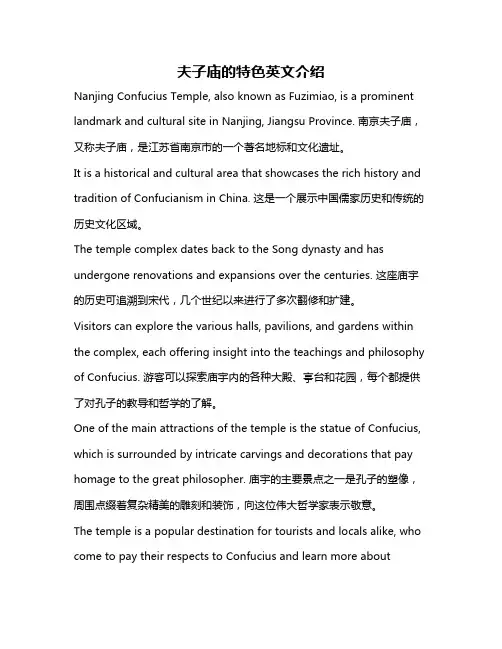
夫子庙的特色英文介绍Nanjing Confucius Temple, also known as Fuzimiao, is a prominent landmark and cultural site in Nanjing, Jiangsu Province. 南京夫子庙,又称夫子庙,是江苏省南京市的一个著名地标和文化遗址。
It is a historical and cultural area that showcases the rich history and tradition of Confucianism in China. 这是一个展示中国儒家历史和传统的历史文化区域。
The temple complex dates back to the Song dynasty and has undergone renovations and expansions over the centuries. 这座庙宇的历史可追溯到宋代,几个世纪以来进行了多次翻修和扩建。
Visitors can explore the various halls, pavilions, and gardens within the complex, each offering insight into the teachings and philosophy of Confucius. 游客可以探索庙宇内的各种大殿、亭台和花园,每个都提供了对孔子的教导和哲学的了解。
One of the main attractions of the temple is the statue of Confucius, which is surrounded by intricate carvings and decorations that pay homage to the great philosopher. 庙宇的主要景点之一是孔子的塑像,周围点缀着复杂精美的雕刻和装饰,向这位伟大哲学家表示敬意。
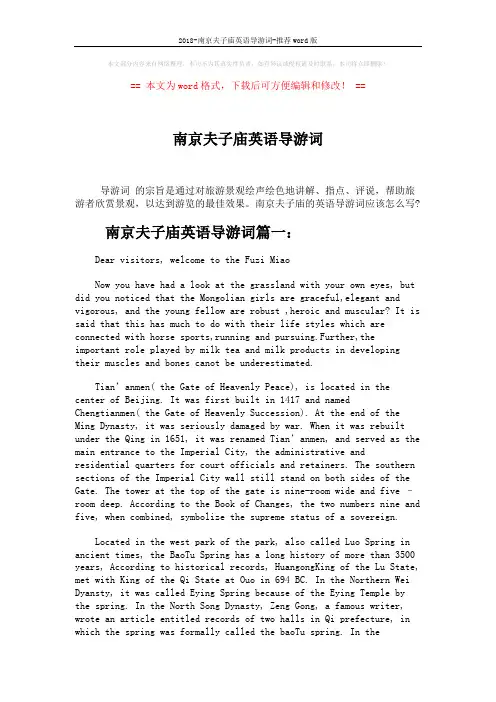
本文部分内容来自网络整理,本司不为其真实性负责,如有异议或侵权请及时联系,本司将立即删除!== 本文为word格式,下载后可方便编辑和修改! ==南京夫子庙英语导游词导游词的宗旨是通过对旅游景观绘声绘色地讲解、指点、评说,帮助旅游者欣赏景观,以达到游览的最佳效果。
南京夫子庙的英语导游词应该怎么写?南京夫子庙英语导游词篇一:Dear visitors, welcome to the Fuzi MiaoNow you have had a look at the grassland with your own eyes, but did you noticed that the Mongolian girls are graceful,elegant and vigorous, and the young fellow are robust ,heroic and muscular? It is said that this has much to do with their life styles which are connected with horse sports,running and pursuing.Further,theimportant role played by milk tea and milk products in developingtheir muscles and bones canot be underestimated.Tian’anmen( the Gate of Heavenly Peace), is located in thecenter of Beijing. It was first built in 1417 and namedChengtianmen( the Gate of Heavenly Succession). At the end of the Ming Dynasty, it was seriously damaged by war. When it was rebuilt under the Qing in 1651, it was renamed T ian’anmen, and served as the main entrance to the Imperial City, the administrative andresidential quarters for court officials and retainers. The southern sections of the Imperial City wall still stand on both sides of the Gate. The tower at the top of the gate is nine-room wide and five –room deep. According to the Book of Changes, the two numbers nine and five, when combined, symbolize the supreme status of a sovereign.Located in the west park of the park, also called Luo Spring in ancient times, the BaoTu Spring has a long history of more than 3500 years, According to historical records, HuangongKing of the Lu State, met with King of the Qi State at Ouo in 694 BC. In the Northern Wei Dyansty, it was called Eying Spring because of the Eying Temple bythe spring. In the North Song Dynasty, Zeng Gong, a famous writer, wrote an article entitled records of two halls in Qi prefecture, in which the spring was formally called the baoTu spring. In theJinDynasty, a stele was erected by the spring, saying that the BaoTu Spring was first among the 72 famous springs.The Fuzi Miao in Nanjing was originally constructed in the yearof 1034 in the Song Dynasty. It was a place to worship and consecrate Confucius, the great philosopher and educator of ancient China. This temple suffered repeated damage and has been rebuilt on several occasions since that time. 1937 was the most destruction when it was burnt to ruin by Japanese aggressors. In 1984 the temple was rebuilt under the support of the local government. During the long process, the original building expanded to be a complex building in the architectural style of the Ming (1368-1644) and Qing (1644-1911) dynasties, including the Fuzi Miao itself, the Jiangnan Gongyuan (the place of imperial examinations) and the Xue Gong (the Imperial Academy). The complex is still called the Fuzi Miao out of habit by locals and visitors.南京夫子庙英语导游词篇二:The Confucius temple in nanjing, often referred to as the Confucius temple, is a temple in gongyuan street, north of qinhuai river, nanjing. "Fu zi" was the title of Confucius disciples to Confucius. At present, the qinhuai scenic area, which is the centerof the temple and the city of the temple, is a cultural activity center integrating culture, tourism, shopping, service and other functions. There is a temple elementary school nearby.Confucius temple scenic spot of the ancient architectural complexes by Confucius temple, east, south Hiram's hospital and so on, the six dynasties to the Ming and qing dynasties, the tide polymersin Confucius temple area, known as the "six dynasties powders to" hub for jiangnan culture, is the core of the beside qinhuai scenery zone. Fuzi temple market is a famous traditional ancient market in China. The jinling Lantern Festival, which is held at the temple ofConfucius during the Spring Festival to the Lantern Festival, is oneof the most important activities during the Spring Festival.The fuzi temple was built in the first year of song dynasty (1034) and was expanded from the old site of the eastern jin dynasty. In the southern song dynasty, it was destroyed by fire and destroyed by fire, and the shaoxing period rebuilt, for jiankang fu xue, while building the imperial court of jiangnan; The yuan dynasty is the ji qing lu science, the early Ming dynasty is the imperial prison, and then the tianfu school; The qing dynasty became a county of jiangning andshangyuan county, which was severely damaged by the Japanese army's incineration in 1937 after the reconstruction of the qing dynasty (1869).In 1984, the people's government of the city and district protected the cultural heritage of the ancient capital. Through the scientific demonstration and planning of relevant experts, several funds were allocated, and years of careful maintenance and reconstruction were made. Today, the temple of Confucius has been renewed and magnificent. Known as qinhuai scenic spot, it has become the characteristic landscape area of the ancient city of nanjing, and is also a popular tourist attraction at home and abroad. In 1991, it was rated as one of the "40 best tourist attractions" in China.Confucius temple before paichi by qinhuai river, the north by the whole stone carved into a boulder fence was built MingZhengDe nine years (in 1514), the nanjing Confucius temple reserves the most well-preserved ancient buildings; The south bank stone wall was built in the three years (1575), 110 meters long and 10 meters high. In front of the north bank temple, there are star pavilions and sileting; The central axis has the lattice star gate, dacheng door, dacheng hall, mingde hall, zang jingge; The temple has a star pavilion.以下文字仅用于测试排版效果, 请使用时删除!冬是清寒的。
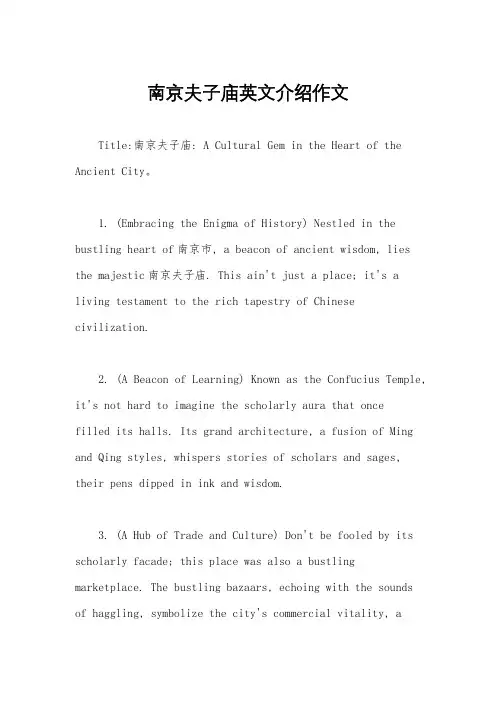
南京夫子庙英文介绍作文Title:南京夫子庙: A Cultural Gem in the Heart of the Ancient City。
1. (Embracing the Enigma of History) Nestled in the bustling heart of南京市, a beacon of ancient wisdom, lies the majestic南京夫子庙. This ain't just a place; it's a living testament to the rich tapestry of Chinesecivilization.2. (A Beacon of Learning) Known as the Confucius Temple, it's not hard to imagine the scholarly aura that oncefilled its halls. Its grand architecture, a fusion of Ming and Qing styles, whispers stories of scholars and sages, their pens dipped in ink and wisdom.3. (A Hub of Trade and Culture) Don't be fooled by its scholarly facade; this place was also a bustling marketplace. The bustling bazaars, echoing with the soundsof haggling, symbolize the city's commercial vitality, atestament to its past as a trading hub.4. (A Cultural Feast) The annual Qinhuai Lantern Festival, a spectacle of light and color, brings the temple to life. The vibrant lanterns, each with a tale, paint a vivid picture of the city's festive spirit.5. (A Living Museum) Today, it's not just a place to visit; it's a place to connect. Tourists and locals alike, find solace in the tranquil gardens, where the whispers of the past blend seamlessly with the present.6. (A Call to Reflection) As you wander its cobbled streets,南京夫子庙 invites you to ponder the timeless lessons of Confucianism. It's a place where history and tradition meet the ever-evolving present, a living reminder of the city's enduring spirit.In essence,南京夫子庙 is a living, breathing entity, a fusion of past, present, and future, a place where every visit is a journey into the soul of南京. So, come, letthis cultural gem enchant you.。
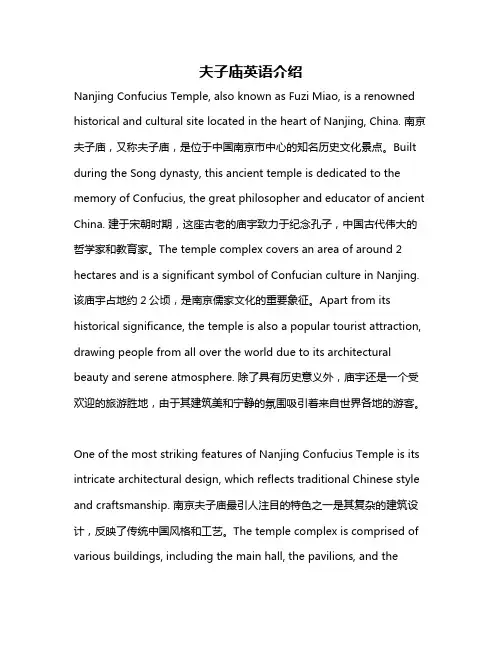
夫子庙英语介绍Nanjing Confucius Temple, also known as Fuzi Miao, is a renowned historical and cultural site located in the heart of Nanjing, China. 南京夫子庙,又称夫子庙,是位于中国南京市中心的知名历史文化景点。
Built during the Song dynasty, this ancient temple is dedicated to the memory of Confucius, the great philosopher and educator of ancient China. 建于宋朝时期,这座古老的庙宇致力于纪念孔子,中国古代伟大的哲学家和教育家。
The temple complex covers an area of around 2 hectares and is a significant symbol of Confucian culture in Nanjing. 该庙宇占地约2公顷,是南京儒家文化的重要象征。
Apart from its historical significance, the temple is also a popular tourist attraction, drawing people from all over the world due to its architectural beauty and serene atmosphere. 除了具有历史意义外,庙宇还是一个受欢迎的旅游胜地,由于其建筑美和宁静的氛围吸引着来自世界各地的游客。
One of the most striking features of Nanjing Confucius Temple is its intricate architectural design, which reflects traditional Chinese style and craftsmanship. 南京夫子庙最引人注目的特色之一是其复杂的建筑设计,反映了传统中国风格和工艺。
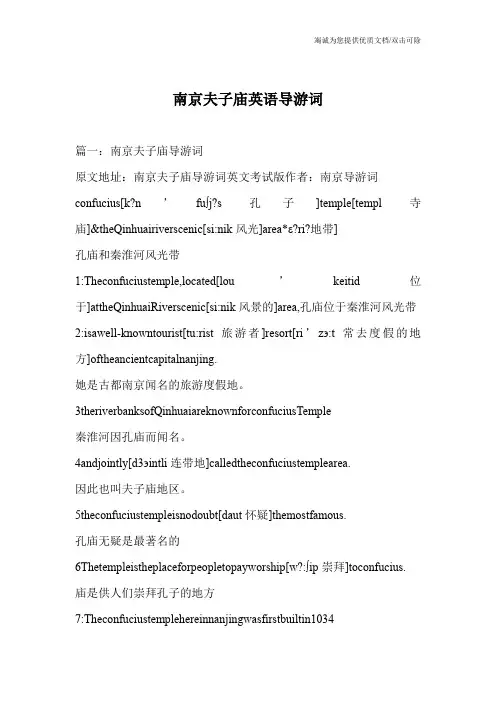
南京夫子庙英语导游词篇一:南京夫子庙导游词原文地址:南京夫子庙导游词英文考试版作者:南京导游词confucius[k?n’fu∫j?s孔子]temple[templ寺庙]&theQinhuairiverscenic[si:nik风光]area*ε?ri?地带]孔庙和秦淮河风光带1:Theconfuciustemple,located[lou’keitid位于]attheQinhuaiRiverscenic[si:nik风景的]area,孔庙位于秦淮河风光带2:isawell-knowntourist[tu:rist旅游者]resort[ri’zэ:t常去度假的地方]oftheancientcapitalnanjing.她是古都南京闻名的旅游度假地。
3theriverbanksofQinhuaiareknownforconfuciusTemple秦淮河因孔庙而闻名。
4andjointly[d3эintli连带地]calledtheconfuciustemplearea.因此也叫夫子庙地区。
5theconfuciustempleisnodoubt[daut怀疑]themostfamous.孔庙无疑是最著名的6Thetempleistheplaceforpeopletopayworship[w?:∫ip崇拜]toconfucius. 庙是供人们崇拜孔子的地方7:Theconfuciustemplehereinnanjingwasfirstbuiltin1034孔庙在南京第一次建于1034。
8andrebuilt[ri:blt重建]in1986重建于1986年9Thetempleweoftenmentioned[men∫?n提出]shouldinclude[inklu:d包括]threearchitectural[a:kitekt∫?r?建筑]complexes[kэmpleks群,综合体]:我们常提的孔庙应该包括三个建筑群:10thetempleofconfuciuswiththehallofgreatachievements[?’t∫i:vm?nt大成]asthemain[mein主要的]body,孔庙及主体建筑大成殿11thepalace[p?lis宫殿]oflearningandtheimperial[impi?ri?l帝国]examination[igz?mi’nei∫?n考试]center.学宫和国家考试中心。
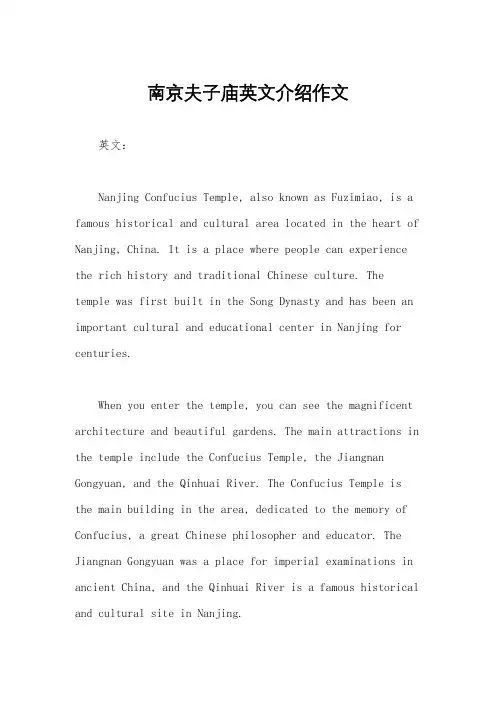
南京夫子庙英文介绍作文英文:Nanjing Confucius Temple, also known as Fuzimiao, is a famous historical and cultural area located in the heart of Nanjing, China. It is a place where people can experience the rich history and traditional Chinese culture. The temple was first built in the Song Dynasty and has been an important cultural and educational center in Nanjing for centuries.When you enter the temple, you can see the magnificent architecture and beautiful gardens. The main attractions in the temple include the Confucius Temple, the Jiangnan Gongyuan, and the Qinhuai River. The Confucius Temple is the main building in the area, dedicated to the memory of Confucius, a great Chinese philosopher and educator. The Jiangnan Gongyuan was a place for imperial examinations in ancient China, and the Qinhuai River is a famous historical and cultural site in Nanjing.In addition to the historical and cultural significance, Fuzimiao is also a popular tourist destination with many shops, restaurants, and traditional performances. Visitors can enjoy traditional Chinese music, opera, and dance performances in the temple area. The surrounding streetsare filled with traditional Chinese architecture and offera wide variety of local snacks and souvenirs.The temple is also a popular spot for locals to gather and relax. It is a great place to take a leisurely stroll, enjoy a cup of tea, or simply soak in the atmosphere.During the evening, the temple is beautifully illuminated, creating a magical and enchanting atmosphere.Overall, Nanjing Confucius Temple is a must-visit destination for anyone interested in Chinese history and culture. It offers a unique blend of historical significance, cultural experiences, and modern entertainment.中文:南京夫子庙,又称夫子庙,是位于中国南京市中心的著名历史文化区域。
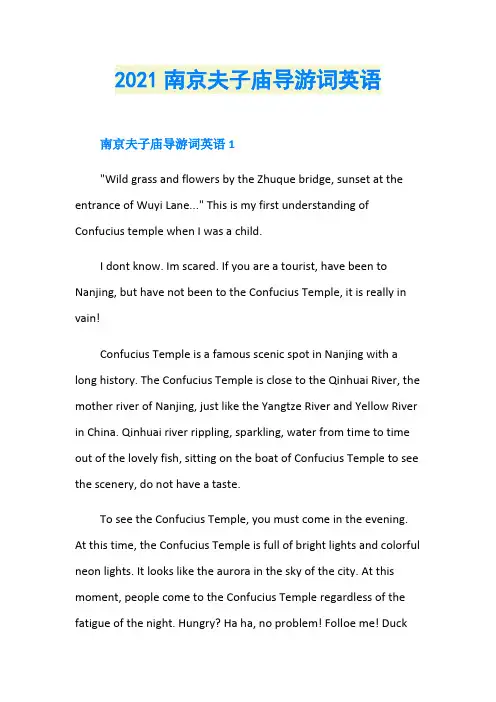
2021南京夫子庙导游词英语南京夫子庙导游词英语1"Wild grass and flowers by the Zhuque bridge, sunset at the entrance of Wuyi Lane..." This is my first understanding of Confucius temple when I was a child.I dont know. Im scared. If you are a tourist, have been to Nanjing, but have not been to the Confucius Temple, it is really in vain!Confucius Temple is a famous scenic spot in Nanjing with a long history. The Confucius Temple is close to the Qinhuai River, the mother river of Nanjing, just like the Yangtze River and Yellow River in China. Qinhuai river rippling, sparkling, water from time to time out of the lovely fish, sitting on the boat of Confucius Temple to see the scenery, do not have a taste.To see the Confucius Temple, you must come in the evening. At this time, the Confucius Temple is full of bright lights and colorful neon lights. It looks like the aurora in the sky of the city. At this moment, people come to the Confucius Temple regardless of the fatigue of the night. Hungry? Ha ha, no problem! Folloe me! Duckblood vermicelli soup, chicken juice soup bag, mutton kebab, not enough to KFC! McDonalds also has! And Nanjing stinky tofu and other classic snacks By the way! There are salted duck! Salted duck is a specialty of Nanjing! Welcome to taste! One of the salted duck is called osmanthus duck, which is improving on the level of salted duck, with the fragrance of osmanthus. Confucius Temple is not the "No.2 lion bridge". Its just food. There are many fashionable shops for you to visit. Of course, your eyes will not be idle. The Confucius Temple is an ancient building long ago, which contains the flavor of old Nanjing. The exquisite carving on the walls and the gorgeous national pattern on the roof are so beautiful. In addition, the Qinhuai River at night is even more beautiful. The clear water reflects the starry night sky, green trees, buildings, and the colorful lights, which make the Qinhuai River colorful.On the Lantern Festival, the Confucius Temple is full of people. There are small shops selling lanterns in the streets, including lovely rabbit lanterns, ancient horse lanterns and Kongming lanterns. In addition to lanterns, there are many lantern shops in the Confucius Temple during the Lantern Festival. Lantern Festival has big and small, big inside sesame, small bubble sugar water, are very delicious.We believe that not only the Confucius Temple, but also Nanjing, a city with a long history, will have a better future!南京夫子庙导游词英语2Located in the south of Jiankang road in Nanjing City, it mainly refers to the Confucius Temple, Xuegong and Gongyuan, but the streets around these three buildings are traditionally called Confucius Temple. In the area of about 0.5 square kilometers from pingjiangfu road in the east to Zhanyuan road in the west, there are more than 300 shopping malls and shops, 2 cinemas and many hotels and amusement parks, etc., and there is an underground commercial street of about 10000 square meters underground. It can be said that Confucius Temple is a multi-functional service center integrating tourism, culture, commerce, catering and entertainment. More than 150000 people attended the festival, especially during the Jinling Lantern Festival. In 337, the Prime Minister Wang Dao built a school Palace on the North Bank of the Qinhuai River, which is the earliest building of Confucius Temple.In 1032, Emperor Renzong built Confucius Temple and Confucius Temple in front of the Academy. Later, it was destroyed several times and rebuilt several times due to war. The present building was rebuilt in 1984. It reproduces the style and landscapeof Jiangnan market in the Ming and Qing Dynasties. Confucius Temple is a place for offering sacrifices to Confucius, covering an area of 26300 square meters. Zhaobi is located on the South Bank of Qinhuai River. It is 10 meters high and 110 meters long. The top of the wall is covered with small cylinder green tiles and the four corners are slightly tilted. Its length is the longest in China.There is a crescent shaped panchi on the north bank and a row of carved stone railings built in the Ming Dynasty on the bank. On the east side of the stone fence is kuiken pavilion with three floors and six flying angles; on the north side is Wenshu square with four pillars and three gates, with four gold characters "Tianxia Wenshu" engraved in the middle; on the west side is Juxing pavilion with double eaves and carved ridge flying angles, and in front of Dacheng gate is Lingxing gate with six pillars and three gates. The buildings here all have the word "Star", which means that the stars of the world are gathered here. Dachengmen is an ancient building with a beam and a bucket. It has a Dragon Ridge and three doors standing side by side. Each door has 45 studs and a faucet ring. On the left and right sides of the gate stand four stone tablets of the Southern Qi, yuan and Song Dynasties, and on both sides of the inner courtyard are corridors connecting the Dacheng hall. Dacheng hall is the main building of Confucius Temple. It is 16.2 meters high,27.3 meters wide and 20.9 meters deep. It has seven Ying double eaves, four slopes and five ridges. The standing carving of dragon and pearl on the main ridge is the first in China. With 56 huge stones in the hall, it is majestic and spectacular. In front of the hall, the bronze statue of Confucius in Danlong, 4.18 meters high, is the highest in China. Outside the walls on both sides of the East and West are the East and West markets carefully planned and designed according to the style of the Ming and Qing Dynasties, mainly dealing in antique jade, four treasures of the study, famous calligraphy and paintings and tourist souvenirs. Located at the back of Dacheng hall, the academy is composed of Mingde hall, Zunjing Pavilion, Chongsheng temple, Qingyun tower and other buildings. It is the highest Academy in ancient state capital. Mingde hall is the main hall of the Academy, which is now a playground.From Wenshufang to the East, you can see a square three story wooden structure building with a bucket arch and cornice Mingyuan building. It is the central building of the former Jiangnan Gongyuan. It is the place to monitor examinees and issue orders during examinations. On both sides of the courtyard behind the building are the imperial examination houses of the Ming and Qing Dynasties. The house is about 1.5 meters long and wide. There are only two boards on the top and the bottom, with tables on the topand benches on the bottom. The examinees eat, drink and sleep in this narrow space for a few days. All the food they bring in should be checked, and even the steamed bread should be cut to prevent cheating. In its heyday, Jiangnan Gongyuan covered an area of more than 70000 square meters, with 20644 houses, the largest scale of Gongyuan in China. Mingyuanlou is now known as "Jiangnan Gongyuan site", which is a provincial cultural relic protection unit. The Confucius Temple in history used to be an abnormal bustling city, especially in the Ming and Qing Dynasties, when it opened in autumn, tens of thousands of candidates (up to 20000 people) gathered here, so bookstores, teahouses and inns came into being, and restaurants and brothels also proliferated. At that time, some streets and alleys on the South Bank of the Qinhuai River were the "gentle townships" and "gold selling caves" for the children of rich families. There were also many famous prostitutes, such as Li Xiangjun and Dong Xiaowan, known as "Qinhuai eight beauties". Today, Meixiang building is rebuilt at 38 chaoku street, which is open to visitors as Li Xiangjuns former residence.Wu Jingzi, a famous writer in Qing Dynasty, once lived on the Bank of Qinhuai River. After 19 years, he wrote a famous book "scholars history" which criticized the imperial examination system. On the site of his former residence, Qinhuai Water Pavilion, abuilding of the style of river hall and river house in Ming and Qing Dynasties has been built, which is called "Qinhuai family" hotel. There are folk activities such as antique wedding and so on. At present, more than 100 kinds of traditional snacks have been discovered. With foreign fast food such as KFC and McDonalds, visitors can enjoy them. Jinling Lantern Festival is even more famous. Its called the Lantern Festival on the 12th and the Lantern Festival on the 18th of the first month of the lunar calendar. In fact, since the beginning of the new year, people have been buying, selling and watching lanterns. There are dozens of colorful lanterns, which make people dazzled and confused.南京夫子庙导游词英语3Ladies and gentlemen. During yesterdays tour, I arranged for you to visit such places of interest as Zhongshan Mausoleum, Ming Xiaoling Mausoleum, Linggu Temple and the former site of the presidential palace. Today, I will take you to Qinhuai River and Confucius Temple. Qinhuai River tourist area is located in the south of the old urban area of Nanjing. It takes about 20 minutes to get there by bus from the urban area. It is a tourist destination with Confucius Temple as the center, integrating sightseeing, shoppingand tasting, displaying the style and features of the ancient city and ethnic customs.[origin and historical changes of Qinhuai River]Qinhuai River is a river that once played an important role in the political, economic and cultural development of the ancient city of Nanjing. It is said that the Qinhuai River is an artificial canal ordered by the first emperor of Qin Dynasty. When the first emperor of Qin Dynasty visited Kuaiji in the East, in order to facilitate the navigation of ships, he ordered to dig Fangshan to connect the Huaihe River with the Yangtze River. However, according to geological investigation, Qinhuai River is a natural river with a long history. At that time, the ancient river did pass through Fangshan. However, due to geographical changes, the river changed its course and gradually formed the present river. The Qinhuai River in history has a wide channel. Since Yang xingmi, king of Wu in the Five Dynasties, built the stone city in the area of changganqiao, the river began to narrow and was divided into the inner and outer Qinhuai River. The Inner Qinhuai River flows from the city of dongshuiguan, through the Confucius Temple, and then from the city of xishuiguan in the south of Shuiximen to join the outer Qinhuai River. The total length of the river is 10 kilometers. This isthe "Ten Mile Qinhuai River" that has been praised and visited by countless scholars and scholars since ancient times. Li Bai, Liu Yuxi and Du Mu, the great poets of Tang Dynasty, wrote poems for her. Kong Shangrens Peach Blossom Fan and Wu Jingyangs scholars also vividly described the "ten li Qinhuai River".Compared with the Yangtze River, which flows through the north of Nanjing City, the ancient Qinhuai River is very small, but it is closely related to the birth and development of Nanjing City, as well as the political, economic and cultural development of Nanjing area. As early as five or six thousand years ago in the Neolithic age, there have been human reproduction. So far, as many as 50 or 60 relics of primitive villages have been found along both sides of the river. In the Six Dynasties and the early Ming Dynasty, the feudal court always regarded it as a natural barrier for the capital and a natural passage for the imperial palace. After the establishment of the capital Jianye (Nanjing), Sun Quan of the eastern Wu Dynasty used to make "gate ponds" on both sides of the Qinhuai River, which could not only resist the enemy, but also prevent floods. Since the Six Dynasties, both sides of the Qinhuai River in the area of Confucius Temple have been prosperous places with dense residents and connected markets. The Qinhuai River has served as the main channel for foreign trade in Nanjing, with boats and boatsshuttling through the river. It is said that in the old days, there were many song houses and restaurants on both sides of the Qinhuai River, the river houses and water pavilions were full of splendor, the yacht paintings were well lighted, and the rich and noble lived a life of pleasure and money. The working people, especially the vast number of women, had a good taste of the bitterness of the world. At that time, prostitutes in Nanjing were mostly concentrated on both sides of the Qinhuai River. Li Xiangjun, a famous prostitute who is not afraid of power and nobility, is described in Peach Blossom Fan by Kong Shangren, a dramatist in Qing Dynasty. She lives by wendeqiao on the South Bank of Qinhuai River.The beautiful Qinhuai River once flowed the loneliness of the wild age, the prosperity and extravagance since the Six Dynasties, the dirt of the old society, the blood and tears of the working people, and even the blood of the Nanjing Massacre. However, todays Qinhuai River, after the precipitation of history and the transformation of the people, has exuded the fragrance of health and civilization, showing a clear and moving style. It is the witness of Nanjings history. No wonder people used to take "Qinhuai" as the pronoun of Nanjing.[Qinhuai boat - Banchi - Zhaobi of Confucius Temple - Square in front of the temple - Lingxing gate]Ladies and gentlemen: now we come to the Bank of the Qinhuai River. The painted defenses in the river are all made in the style of Ming Dynasty architecture, with big red balls and red lanterns hanging on the bow. Whenever the Lantern Festival, Nanjing people used to come here to enjoy the lights. It is said that after the establishment of the capital of Ming Dynasty, Zhu Yuanjin paid a visit to the capital. When he came to the Bank of the Qinhuai River, he saw trees on both sides of the river, clear water, pavilions and pleasant scenery. He said casually, "Im sorry for the lack of boats in the river." When the emperor opened the golden gate, he sent people all night to build the boat in order to win the favor of the emperor. Since then, Qinhuai painting has become a major feature here. Especially in the Mid Autumn Festival, tens of thousands of lanterns are in full bloom on the river, and dragon lanterns are dancing on both sides of the river. Songs, drums, cheers and laughter are continuous all night. It can be said that "Qinhuai is the best in the world". No wonder there is a folk saying in Nanjing that "every family walks on the bridge, everyone looks at the light".This section of Qinhuai River in front of us has become a Confucius Temple (Confucius Temple) and panchi since the Song Dynasty, also known as crescent moon. In ancient times, the Imperial Academy was called Biyong, and the princes Academy was called Pangong. The Confucius Temple Academy was equivalent to the place where the princes gave lectures, so this pool was called "panchi". Generally, there are three stone bridges built on panchi. According to the grade, county officials and students take the middle one, and scholars take the bridges on both sides. It is said that in ancient times, a scholar mistakenly went to Zhongqiao. He was in a dilemma and had to jump into panchi by himself.Please look at a section of vermilion stone brick wall on the other side of the river. This is the screen wall of Confucius Temple. Zhaobi was built in the third year of Wanli in the Ming Dynasty (Li Ze Nian), 110 meters long, which is the highest Zhaobi in the whole family. Ladies and gentlemen, this Confucius Temple was built in 337, the third year of emperor chengdi of the Eastern Jin Dynasty. At that time, Emperor chengdi adopted the advice of Wang Dao: "the cultivation of talents is the most important thing in governing the country", and decided to establish the University on the Bank of Qinhuai river. In the first year of Jingpai (1034), the Confucius Temple was built on the basis of Xuefu. Therefore, ConfuciusTemple is a bustling city evolved from a cultural and educational center. It includes three main buildings: Confucius Temple, Academy and Gongyuan. Its scope is adjacent to the North Bank of Qinhuai River in the south, the east end of Jiankang road in the north, Yaojia Lane in the East and Sifu Lane in the West. Although the Confucius Temple was destroyed many times, it was built and expanded in different dynasties. By the end of the Qing Dynasty and the beginning of the Republic of China, the structure and layout of its pavilions and temples were the best in the southeast. The present Confucius Temple is partly rebuilt in the late Qing Dynasty and partly rebuilt in recent years. Please look back. This pavilion style building is called Kuixing Pavilion. It was first built in Qianlong period of Qing Dynasty. The waterfront building was destroyed twice and rebuilt in 1985.Now we come to the square in front of the temple opened up in the Qing Dynasty. There are two steles standing at the East and West ends of the square, about one foot high, on which are engraved two words in Manchu and Chinese: "Minister of culture and military dismounts here", which shows respect for the sage Confucius. The pavilion with six corners and double eaves on the left is called "star gathering Pavilion", which means that all the stars are concentrated and talents are gathered. It was built in the 14thyear of Wanli in the Ming Dynasty (1586), but it was not rebuilt until the 8th year of Tongzhi in the Qing Dynasty (1869). This is the only Qing Dynasty building that survived the Japanese artillery fire. Unfortunately, it was demolished as "four old" in 1968 and rebuilt in 1983, restoring its original style. The memorial archway in the middle of the square is called "Tianxia Wenshu archway". Please continue to follow me. This gate is called Lingxing gate, which is the gate of Confucius Temple. It is said that TA Xing is the star in charge of education in the sky. He is convenient and happy. The gate is a stone structure with six columns and three gates. It was built in 1480, the 16th year of Chenghua in the Ming Dynasty. It was later destroyed and rebuilt in 1870. However, the polar gate we see now was rebuilt in 1983. The East and west sides of the gate are the East and West markets.南京夫子庙导游词英语4Hello, everyone! Welcome to Nanjing Confucius Temple. The Confucius Temple is located on the Bank of Qinhuai River in the south of the city. It is a historic site and tourist attraction that Nanjing people are proud of. It is a prosperous place where culture, commerce, sightseeing center and Temple market are integrated.Confucius Temple, also known as Confucius Temple and Confucian temple, is a place to offer sacrifices to Confucius, a famous educator and thinker in China. Confucius was honored as Confucius in ancient times, so his temple is commonly known as "Confucius Temple". Due to the orthodox status of Confucianism, its founder Confucius was highly respected by the rulers and scholars of feudal society. There were more than one Confucius temples all over the country. As a place for feudal scholars to worship, Confucius Temple is mostly arranged together with educational facilities (such as school palace, Gong Yuan, etc.), that is, the so-called temple is attached to school, usually in front or on one side of the school palace.Historically, there were three Confucius temples in the urban area of Nanjing, one in the compound of the current municipal government and the other in the Chaotian Palace. Now we are going to visit the third and most famous place. It was moved from Chaotian Palace in the first year of Jingyou of Song Dynasty (1034). At first, it was Jiankang school, Jiqing road school in Yuan Dynasty, Guoxue in Ming Dynasty, yingtianfu school in Qing Dynasty, and Jiangning school and Shangyuan school in Qing Dynasty. It was destroyed in the Xianfeng Period, rebuilt in the Tongzhi period (1869), and burned by the Japanese during the Anti Japanese war.The existing Confucius Temple was rebuilt in the early 1980s. It uses the former temple and the later school, Confucius Temple in the front and the Academy in the back, and the later Gong Yuan is arranged on the left side of the Academy. Therefore, the relatively complete pattern of Confucius Temple in Nanjing includes three parts, namely, Confucius Temple, Academy and Gongyuan. The North-South central axis with Dacheng hall as the center and the main buildings on both sides and the Jiangnan Gongyuan exhibition hall with Mingyuan building as the center have become the main tourist spots in the Confucius Temple area.Due to its long history and convenient water transportation, Confucius Temple area has become a famous "beautiful place" and a place where celebrities live in ancient Nanjing before the appearance of Confucius Temple. Therefore, in addition to the main scenic spots mentioned above, there are also scenic spots such as Wu Jingzis former residence, ancient taoyedu, Cuiyuan, one hundred year old shop Street, wendeqiao, Wang Xies former residence, Wuyi lane, meixianglou, etc.Now we are standing at the starting point of the central axis of Confucius Temple - Confucius Temple Square. Looking around, there are panchi, Zhaobi and mufang in the south, Juxing Pavilion,KuiGuang Pavilion and business district in the East and West, Dacheng hall in the central axis and the East and West cities on the East and west sides of Confucius Temple in the north, which form the unique atmosphere of Confucius Temple area different from other cities, that is, the pattern of Temple market integration in history.Look at the river in front of the square. Its called Qinhuai River. Its the mother river of Nanjing people. Its 110 kilometers long and gave birth to the early Nanjing civilization. The section that flows through the square is a part of the Inner Qinhuai River. When the temple was built, it was transformed into panchi, named after the water flowing through the Confucius Temple in Qufu. A red wall on the south bank is a large screen wall built in the Wanli period of the Ming Dynasty (1575). It is 110 meters long and majestic. It is the largest screen wall in China. Zhaobi played a role of shelter and decoration, which was the beginning of the whole Confucius Temple complex. The stone railings on the North Bank of panchi were built in Zhengde (1514) of the Ming Dynasty. After many vicissitudes, they became the only best preserved ancient architectural sketch in the Confucius Temple complex, which had been repaired before the Anti Japanese war. Here, visitors take a rest on the fence and enjoy the beautiful scenery of Qinhuai.The Wende bridge on the west side of panchi is now hanbaiyu bridge. It got its name from the Confucian schools advocacy of article morality. Because the direction of the bridge is the same as that of the meridian, every November 15 of the lunar calendar, when the bright moon is in the sky and you look down from the railing, you can see the shadow of the bridge on both sides of the bridge. The bright moon in the river is divided into two and a half months, which is called "Wen de Fen Yue". Wu Jingzi recorded it in his book scholars. If you have a chance, you might as well come to Wende bridge on November 15 of the lunar calendar to have a look.A group of Hui style buildings at the entrance of South Wuyi lane of wendeqiao is called "Wangxie ancient residence". As the settlement area of Wang Xie and Wang Xie in the Eastern Jin Dynasty, it has a great influence, especially the verses of Wu Yi Xiang, the famous work of Liu Yuxi in Tang Dynasty, which makes Wu Yi Xiang and Wang Xies former residence very famous, and now it is "the historical and cultural exhibition Hall of Six Dynasties in Nanjing." You can visit it when you have time.Now, to the north of the stone column is the newly rebuilt Tianxia Wenshu square, which indicates that it is the cultural centerof Tianxia. Three doors and four pillars, quite spectacular. In ancient times, it corresponded to the Lingxing gate at the back, which was used for the emperors to go on a pilgrimage to worship Confucius. The high gate square in the middle was the royal road where the emperor was lucky to come. It was used for the princes of the county to go in and out. The ordinary officials and subjects could not pass through, so it was usually closed with wooden fences.The star gathering Pavilion on the west side of the square in front of the temple has a hexagonal cornice, which is simple and elegant. It looks like a two-layer structure with double cornices on the outside. In fact, it has only one floor. The name of the pavilion is the gathering of stars and talents. In the East, the small courtyard facing the water is KuiGuang Pavilion. The Kuixing Pavilion in the pavilion has three floors and six sides, and faces Qinhuai River. The scenery is unique. In ancient times, there was a saying of "Kui Zhu Wen". Kuixing, or Kuixing, is a sign of prosperity of the literary movement and a symbol of winning the first place in the imperial examination. Therefore, Kuixing was regarded as a God by the students of the past dynasties. KuiGuang Pavilion and Juxing Pavilion look at each other from the east to the west, echoing each other and integrating into one.The stone square gate in the north of the square in front of the temple is the first gate of the Confucius Temple - Lingxing gate, with six columns and three gates. It is simple and beautiful, and the lintel in the middle is engraved with the seal character "Lingxing gate". Lingxing is the "Wenxing" in ancient astronomy. The reason why it is named is to show that scholars in the world gather here. The brick relief inlaid with peony pattern between the three doors is exquisitely carved and gorgeous. The top of the stone column is made of cloud plate, which means Huabiao, as a sign. This is the gate for the emperor to worship Confucius.After passing the Lingxing gate, we came to the Dacheng gate of Dacheng hall.Dachengmen, also known as Jimen, is the main gate of Confucius Temple, with Zhijing gate on both sides. In feudal times, only officials could get in and out of dachengmen, while ordinary scholars could only get in and out from other doors. Entering the gate, there are four ancient steles on the left and right: in the East, there are the stele of fengzhishengs wife in 1331, the remnant stele of Jiqing Confucius Temple in 1330, and the stele of kongyuwenli in 484, which was moved by the municipal government. This book is based on the picture stele of Confucius asking for rites.On both sides of the courtyard and corridor are arranged eight of Confucius twelve students, namely min sang, ran Geng, ran Qiu, Duan Muzi, ran Yong, Zai Yu, Yan Yan and Zhong you. They are all carved from white jade of Han Dynasty. They are very devout and lifelike.Looking forward, the platform in front of the Dacheng hall is Danlong, commonly known as the terrace. It is 1.4 meters high, 21.8 meters wide from east to west, and 14.0 meters long from north to south. It is surrounded by stone railings, 24 cloud looking pillars, and stone lanterns are set at the two corners of the platform. This terrace is used for sacrifice, singing and dancing. The statue of Kongyu in the middle of the terrace is particularly eye-catching. Its made of bronze, 4.18 meters long and weighs 37 tons. Its exquisitely made, lifelike, full-bodied, with a kind and deep face. The eyebrows reveal the wisdom of a great thinker and leave a very deep impression on people. On both sides of the terrace, there were two verandas, which were used to worship the memorial tablets of the 72 sages in Confucius gate and to store sacrificial, ceremonial and dancing utensils. Now it is reduced to a small two veranda and changed into a stele gallery. There are more than 30 steles with ink marks of famous calligraphers such as Zhao Puchu,。
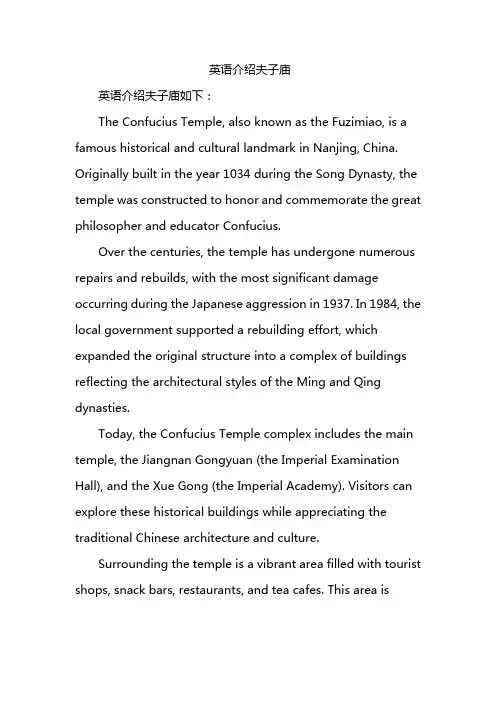
英语介绍夫子庙英语介绍夫子庙如下:The Confucius Temple, also known as the Fuzimiao, is a famous historical and cultural landmark in Nanjing, China. Originally built in the year 1034 during the Song Dynasty, the temple was constructed to honor and commemorate the great philosopher and educator Confucius.Over the centuries, the temple has undergone numerous repairs and rebuilds, with the most significant damage occurring during the Japanese aggression in 1937. In 1984, the local government supported a rebuilding effort, which expanded the original structure into a complex of buildings reflecting the architectural styles of the Ming and Qing dynasties.Today, the Confucius Temple complex includes the main temple, the Jiangnan Gongyuan (the Imperial Examination Hall), and the Xue Gong (the Imperial Academy). Visitors can explore these historical buildings while appreciating the traditional Chinese architecture and culture.Surrounding the temple is a vibrant area filled with tourist shops, snack bars, restaurants, and tea cafes. This area isknown for its traditional Nanjing cuisine, which offers a delicious taste of local flavors.The Confucius Temple is situated beside the Qinhuai River, creating a picturesque setting, particularly in the evening. Many people choose to take boats to admire the beautiful scenery of the temple and the river.Overall, the Confucius Temple is an essential destination for anyone interested in Chinese history, culture, and architecture. It provides a unique glimpse into the past while offering a range of modern attractions and activities.中文翻译孔庙,也被称为府子庙,是中国南京著名的历史文化地标。
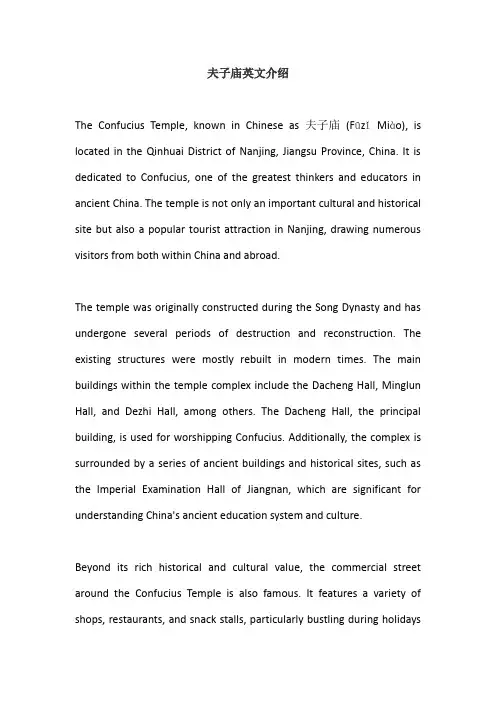
夫子庙英文介绍The Confucius Temple, known in Chinese as 夫子庙(FūzǐMiào), is located in the Qinhuai District of Nanjing, Jiangsu Province, China. It is dedicated to Confucius, one of the greatest thinkers and educators in ancient China. The temple is not only an important cultural and historical site but also a popular tourist attraction in Nanjing, drawing numerous visitors from both within China and abroad.The temple was originally constructed during the Song Dynasty and has undergone several periods of destruction and reconstruction. The existing structures were mostly rebuilt in modern times. The main buildings within the temple complex include the Dacheng Hall, Minglun Hall, and Dezhi Hall, among others. The Dacheng Hall, the principal building, is used for worshipping Confucius. Additionally, the complex is surrounded by a series of ancient buildings and historical sites, such as the Imperial Examination Hall of Jiangnan, which are significant for understanding China's ancient education system and culture.Beyond its rich historical and cultural value, the commercial street around the Confucius Temple is also famous. It features a variety of shops, restaurants, and snack stalls, particularly bustling during holidaysand at night, creating a lively market atmosphere that blends traditional and modern vibes. Visitors can enjoy authentic Nanjing delicacies such as Duck Blood and Vermicelli Soup, Salted Duck, and purchase various souvenirs and handicrafts.The Confucius Temple serves not only as a sightseeing spot but also as an excellent venue for experiencing traditional Chinese culture and educational philosophy. On Confucius' birthday each year, grand ceremonies and cultural activities are held to honor Confucius and his educational ideals. Moreover, the temple frequently hosts various cultural exhibitions and artistic performances, offering visitors a deeper insight into traditional Chinese culture.。
夫子庙英文介绍10词English:Fuzimiao, or Confucius Temple, is a historic cultural site in Nanjing, China, dedicated to honoring the philosopher Confucius. Dating back to 1034 during the Song Dynasty, it has served as an educational center, a venue for Confucian worship, and a gathering place for scholars. The temple features classic Chinese architectural elements, including intricately carved stone, elegant wooden structures, and tranquil courtyards. Visitors can explore the temple's museum, which houses artifacts related to Confucian philosophy and Chinese history. Fuzimiao is also surrounded by a bustling pedestrian area with shops, restaurants, and traditional performances, making it a vibrant spot for both cultural exploration and leisure activities. The temple's role in promoting Confucian ideals and its enduring historical significance make it a key landmark in Nanjing and a popular tourist destination.中文翻译:夫子庙位于中国南京,是一座历史悠久的文化景点,旨在纪念哲学家孔子。
南京夫子庙英文介绍作文英文:Nanjing Confucius Temple, also known as Fuzi Miao, is a famous tourist attraction in Nanjing, China. It is a place where people can experience the rich cultural heritage of China and learn about the teachings of Confucius.The temple complex is a beautiful and well-preserved architectural masterpiece, with traditional Chinese buildings, stone bridges, and tranquil courtyards. As you walk through the temple, you can feel the peaceful atmosphere and admire the intricate details of the buildings.One of the highlights of the temple is the Confucius statue, which is a symbol of respect and reverence for the great philosopher. Visitors can also explore the Confucius Temple Museum, which houses a collection of artifacts related to Confucius and his teachings.In addition to the historical and cultural significance, Fuzi Miao is also a vibrant shopping and dining area. There are numerous shops selling traditional Chinese handicrafts, souvenirs, and delicious local snacks. It's a great placeto immerse yourself in the local culture and enjoy some authentic Chinese cuisine.Overall, a visit to Nanjing Confucius Temple is a must for anyone interested in Chinese history and culture. It'sa place where you can learn, relax, and experience the essence of traditional China.中文:南京夫子庙,又称夫子庙,是中国南京著名的旅游景点。
南京夫子庙英文导游词(范文)第一篇:南京夫子庙英文导游词(范文)Dear visitors, welcome to the Fuzi MiaoThe Fuzi Miao in Nanjing was originally constructed in the year of 1034 in the Song Dynasty.It was a place to worship and consecrate Confucius, the great philosopher and educator of ancient China.This temple suffered repeated damage and has been rebuilt on several occasions since that time.1937 was the most destruction when it was burnt to ruin by Japanese aggressors.In 1984 the temple was rebuilt under the support of the local government.During the long process, the original building expanded to be a complex building in the architectural style of the Ming(1368-1644)and Qing(1644-1911)dynasties, including the Fuzi Miao itself, the Jiangnan Gongyuan(江南贡院)(the place of imperial examinations)and the Xue Gong(the Imperial(帝王)Academy).The complex is still called the Fuzi Miao out of habit by locals and visitors.In front of the Fuzi Miao, the Qin Huai River is flowing.On the south bank of the river, there is the longest screen wall in China which is 110-meter-long(about 120 yards)and piled(堆砌)with bricks(砖).The Dacheng Hall (大成殿)is recommended(推荐)on your trip.It is 16.22 meters high(about 53 feet)and 28.1 meters(about 30 yards)wide featuring a 1.5-meter-high(about 5 feet)pedestal.There are two worthwhile attractions found in the inner hall.One is the largest figure of Confucius in China.The other one is the beautiful collection of 38 vivid panels which are made by various jade, gold and silver, detailing the life of Confucius.Out of the hall, you will see the bronze(青铜)statue of Confucius as well as the white marble(大理石)statues of his eight disciples.(门生)A fantastic insight into how ancient Chinese governments choose officials(行政官员)can be gained from visiting the Jiangnan Gongyuan.It is a sight not to be missed.The development of Gongyuan began in the Southern Song Dynasty(420-589), expanding into the Ming and Qing Dynasties, until in the reign of Emperor Guangxu in the Qing Dynasty.It developed to be the biggest exanimation school in China.The main building of Gongyuan is the three-storied Mingyuan Tower which is surrounded by 20,644 examination cells, called 'haoshe' in Chinese.Now, a specialized museum on the imperial civil examination system is built here.Visitors also have the opportunity to take simulated exams and experience the joys and sorrows of the candidates.The area around the temple consists of a series of tourist shops, snack bars, restaurants and tea cafes.They all appear to be in the architectural style of the Ming and Qing style.A variety of snacks encompassing eight of the most famous flavours are available for purchase at here.Everyone's individual tastes are well catered for.They are necessary parts of food culture in Nanjing.第二篇:南京夫子庙导游词夫子庙导游词位于南京市健康路以南,主要指的是孔庙、学宫、贡院三大建筑群,但习惯上将围绕这三大建筑群一带的街道都称做夫子庙。
夫子庙导游词篇一:南京夫子庙英文导游词Dearvisitors,welcometotheFuzimiao TheFuzimiaoinnanjingwasoriginallyconstructedintheyearof1034inthesong Dynasty.Itwasaplacetoworshipandconsecrateconfucius,thegreatphilosophe randeducatorofancientchina.Thistemplesufferedrepeateddamageandhasbe enrebuiltonseveraloccasionssincethattime.1937wasthemostdestructionwh enitwasburnttoruinbyJapaneseaggressors.In1984thetemplewasrebuiltunde rthesupportofthelocalgovernment.Duringthelongprocess,theoriginalbuildi ngexpandedtobeacomplexbuildinginthearchitecturalstyleoftheming(1368-1644)andQing(1644-1911)dynasties,includingtheFuzimiaoitself,theJiangn angongyuan(江南贡院)(theplaceofimperialexaminations)andthexuegong(theImperial(帝王)Academy).ThecomplexisstillcalledtheFuzimiaooutofhabitbylocalsandvisit ors.InfrontoftheFuzimiao,theQinhuaiRiverisflowing.onthesouthbankoftherive r,thereisthelongestscreenwallinchinawhichis110-meter-long(about120yard s)andpiled(堆砌)withbricks(砖).TheDachenghall(大成殿)isrecommended(推荐)onyourtrip.Itis16.22metershigh(about53feet)and28.1meters(about30yards)widefeaturinga1.5-meter-high(about5feet)pedestal.Therearetwoworthwhileattractionsfou ndintheinnerhall.oneisthelargestfigureofconfuciusinchina.Theotheroneisth ebeautifulcollectionof38vividpanelswhicharemadebyvariousjade,goldand silver,detailingthelifeofconfucius.outofthehall,youwillseethebronze(青铜)statueofconfuciusaswellasthewhitemarble(大理石)statuesofhiseightdisciples.(门生)Afantasticinsightintohowancientchinesegovernmentschooseofficials(行政官员)canbegainedfromvisitingtheJiangnangongyuan.Itisasightnottobemissed.T hedevelopmentofgongyuanbeganinthesouthernsongDynasty(420-589),exp andingintothemingandQingDynasties,untilinthereignofemperorguangxuin theQingDynasty.Itdevelopedtobethebiggestexanimationschoolinchina.The mainbuildingofgongyuanisthethree-storiedmingyuanTowerwhichissurrou ndedby20,644examinationcells,called'haoshe'inchinese.now,aspecialized museumontheimperialcivilexaminationsystemisbuilthere.Visitorsalsohave theopportunitytotakesimulatedexamsandexperiencethejoysandsorrowsofth ecandidates. Theareaaroundthetempleconsistsofaseriesoftouristshops,snackbars,restaur antsandteacafes.TheyallappeartobeinthearchitecturalstyleofthemingandQi ngstyle.Avarietyofsnacksencompassingeightofthemostfamousflavoursarea vailableforpurchaseathere.everyone'sindividualtastesarewellcateredfor.Theyarenecessarypartsoffoodcultureinnanjing.篇二:夫子庙导游词(1)(1)夫子庙1,景点概况—1分钟30秒(秦淮河简介、夫子庙景区特色和历史沿革、5A级景区等)说起夫子庙,我们还得先来谈谈南京的母亲河—秦淮河。
南京夫子庙英文导游词【篇一:南京夫子庙英文导游词】dear visitors, welcome to the fuzi miaothe fuzi miao in nanjing was originally constructed in the yearof 1034 in the song dynasty. it was a place to worship and consecrate confucius, the great philosopher and educator of ancient china. this temple suffered repeated damage and has been rebuilt on several occasions since that time. 1937 was the most destruction when it was burnt to ruin by japanese aggressors. in 1984 the temple was rebuilt under the supportof the local government. during the long process, the original building expanded to be a complex building in the architectural style of the ming (1368-1644) and qing (1644-1911) dynasties, including the fuzi miao itself, the jiangnan gongyuan(江南贡院)(the place of imperial examinations) and the xue gong (the imperial(帝王) academy). the complex is still called the fuzi miao out of habit by locals and visitors.in front of the fuzi miao, the qin huai river is flowing. on the south bank of the river, there is the longest screen wall inchina which is 110-meter-long (about 120 yards) and piled(堆砌) with bricks(砖). the dacheng hall(大成殿) is recommended(推荐) on your trip. it is 16.22 meters high (about 53 feet) and 28.1 meters (about 30 yards) wide featuringa1.5-meter-high (about 5 feet) pedestal. there are twoworthwhile attractions found in the inner hall. one is thelargest figure of confucius in china. the other one is the beautiful collection of 38 vivid panels which are made by various jade, gold and silver, detailing the life of confucius. out of the hall, you will see the bronze(青铜) statue of confucius as well as the white marble (大理石)statues of his eight disciples.(门生)a fantastic insight into how ancient chinese governments choose officials(行政官员) can be gained from visiting the jiangnan gongyuan. it is a sight not to be missed. the development of gongyuan began in the southern song dynasty (420-589), expanding into the ming and qing dynasties, until inthe reign of emperor guangxu in the qing dynasty. it developed to be the biggest exanimation school in china. the main building of gongyuan is the three-storied mingyuan tower which is surrounded by 20,644 examination cells, called haoshe in chinese. now, a specialized museum on the imperial civil examination system is built here. visitors also have the opportunity to take simulated exams and experience the joys and sorrows of the candidates.the area around the temple consists of a series of tourist shops, snack bars, restaurants and tea cafes. they all appearto be in the architectural style of the ming and qing style. a variety of snacks encompassing eight of the most famous flavours are available for purchase at here. everyones individual tastes are well catered for. they are necessary parts of food culture in nanjing.【篇二:夫子庙英文简介】confucius temple is one of the most famous places in nanjing. it was built to memorize confucius, and used to hold imperial examination. but now, it is a scenic spot. confucius temple is very beautiful. you can taste many famous nanjing’s food there, and you can also visit the lantern festival by boat on qinhuai river at night. it attracts many tourists all around the world every year. at the southwest of confucius temple, there is a narrow alley called wuyixiang. it is also very famous. if you come to nanjing, don’t forget to visit confucius temple! i’m looking forward to meeting you in nanjing. thank you.【篇三:13年最新南京夫子庙导游词】夫子庙 a【景点概况】1分30秒1、秦淮河简介2、夫子庙景区特色及历史沿革3、5a级景区等各位游客大家好,现在我们来到秦淮河畔夫子庙游览。
秦淮河古名淮水,又叫龙藏浦,相传是秦始皇开凿,又称秦淮河。
秦淮河是南京人民的母亲河,起源于溧水的东庐山和句容的宝华山。
秦淮河在南京城东分成两支,一支从通济门外的东水关入城,经夫子庙,到水西门外的西水关出城,称为内秦淮河,全长约10里,其沿河两岸,从六朝起便是望族聚居之地,商贾云集,文人荟萃,儒学鼎盛,素有“六朝金粉地,十里秦淮河”之誉。
另一支从城外流过,成为南京城东、城南、城西的护城河。
两支在城西汇合,注入长江。
南京夫子庙通常是指位于南京城南秦淮风光带中心位置的集观光、购物、休闲、餐饮于一体的仿古建筑的商业区。
南京夫子庙是一座仿明清时期的古建筑群,具有典型的徽派建筑风格,整体布局集“庙、市、景”合一,将儒家文化、科举文化、民俗文化、饮食文化、建筑文化等完美的结合在一起。
夫子庙,又叫孔庙、文庙,是祭祀和供奉孔子的庙宇。
南京夫子庙始建于宋景佑元年(1034年),现夫子庙是1986年重建,依然保留前庙后学的布局。
现为国家5a级旅游景区。
【庙前广场】2分钟1、大照壁的体量及作用2、泮池的由来及作用3、文德桥及“文德分月”奇景4、聚星亭、天下文枢坊、魁星阁及棂星门简介现在我们就来到夫子庙前的广场,这是夫子庙的中心地区。
照壁是秦淮河南岸的一段朱红色石砖墙,照壁起遮蔽和装饰作用,是整个夫子庙建筑群的开始。
它建于明万历三年(1575年),长110米高,10米,为全国照壁之冠。
照壁的北面就是泮池,意思是“泮宮之池”。
泮池是文庙前的规制。
南京夫子庙前的泮池与众不同,它是利用内秦淮河天然河道而形成,半月形,南部呈半圆。
文德桥在泮池西侧,因儒家提倡文章道德而得名。
据考证,由于桥向与子午线方向一致,所以每逢农历11月15日,在桥的两边分别可以看到桥影将水中明月分为两个半月,这一景观被称为“文德分月”。
西侧的这座六角重檐亭子叫“聚星亭”,取“群星毕集,人才荟萃”之意,初建于明万历十四年(1586年),曾几经兴废。
这座四柱三门的大牌坊为天下文枢坊。
孔子乃天下文章道德之中枢也,故得此名,这是进入孔庙的标志。
东侧这座临街傍水的楼阁式建筑,叫做奎星阁,始建于清乾隆年间,曾两次被毁,1985年重建。
这座门叫棂星门,“棂星”是古代天文学中的“文星”,在此表示天下文人学士集学于此。